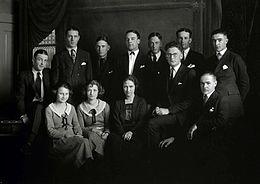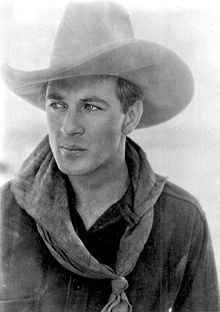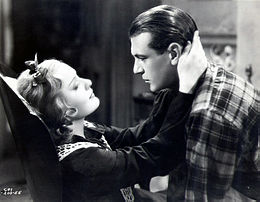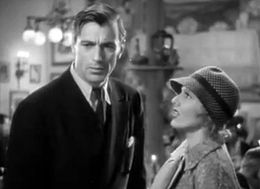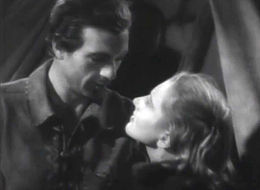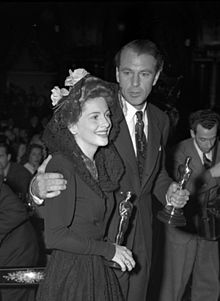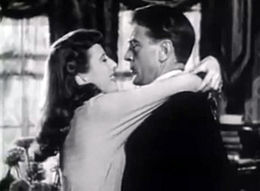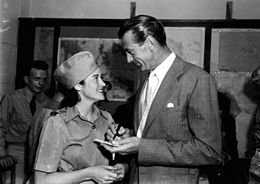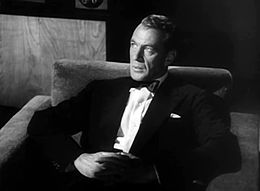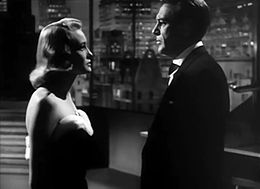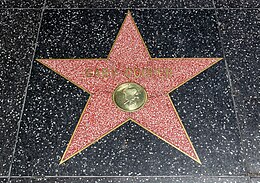Gary Cooper
[19] In 1919, his father arranged for his son to attend Gallatin County High School in Bozeman, Montana,[20][21] where English teacher Ida Davis encouraged him to focus on academics and participate in debating and dramatics.
[47] Cooper's first important film role was a supporting part in The Winning of Barbara Worth (1926) starring Ronald Colman and Vilma Bánky,[47] in which he plays a young engineer who helps a rival suitor save the woman he loves and her town from an impending dam disaster.
[59] Looking to exploit Cooper's growing audience appeal, the studio placed him opposite popular leading ladies such as Evelyn Brent in Beau Sabreur, Florence Vidor in Doomsday, and Esther Ralston in Half a Bride (all 1928).
[61] According to biographer Jeffrey Meyers, the romantic image of the tall, handsome, and shy cowboy hero who embodied male freedom, courage, and honor was created in large part by Cooper in the film.
[62] Unlike some silent-film actors who had trouble adapting to the new sound medium, Cooper transitioned naturally, with his "deep and clear" and "pleasantly drawling" voice, which perfectly suited the characters he portrayed on screen.
[78] After guiding him through the great art museums and galleries of Italy,[78] she accompanied him on a 10-week big-game hunting safari on the slopes of Mount Kenya in East Africa,[79] where he was credited with more than 60 kills, including two lions, a rhinoceros, and various antelopes.
[87] Co-starring Helen Hayes, a leading New York theatre star and Academy Award winner,[88] and Adolphe Menjou, the film presented Cooper with one of his most ambitious and challenging dramatic roles,[88] playing an American ambulance driver wounded in Italy, who falls in love with an English nurse during World War I.
[114] In the film, Cooper plays Longfellow Deeds, a quiet, innocent writer of greeting cards who inherits a fortune, leaves behind his idyllic life in Vermont, and travels to New York City, where he faces a world of corruption and deceit.
In Lewis Milestone's adventure film The General Died at Dawn with Madeleine Carroll, he plays an American soldier of fortune in China who helps the peasants defend themselves against the oppression of a cruel warlord.
[127] The film was an even greater box-office hit than its predecessor,[128] due in large part to Jean Arthur's definitive depiction of Calamity Jane and Cooper's inspired portrayal of Hickok as an enigmatic figure of "deepening mythic substance".
[154] In Henry Hathaway's The Real Glory (1939), he plays a military doctor who accompanies a small group of American Army officers to the Philippines to help the Christian Filipinos defend themselves against Muslim radicals.
[162][Note 4] In the film, Cooper plays a Texas Ranger who pursues an outlaw into western Canada, where he joins forces with the Royal Canadian Mounted Police who are after the same man, a leader of the North-West Rebellion.
"[168] In the film, Cooper plays Long John Willoughby, a down-and-out bush-league pitcher hired by a newspaper to pretend to be a man who promises to commit suicide on Christmas Eve to protest all the hypocrisy and corruption in the country.
[176] The film chronicles York's early backwoods days in Tennessee, his religious conversion and subsequent piety, his stand as a conscientious objector, and finally his heroic actions at the Battle of the Argonne Forest, which earned him the Medal of Honor.
[196] Soon after the publication of Ernest Hemingway's novel For Whom the Bell Tolls, Paramount paid $150,000 for the film rights with the express intent of casting Cooper in the lead role of Robert Jordan,[197] an American explosives expert who fights alongside the Republican loyalists during the Spanish Civil War.
[202] While the film distorted the novel's original political themes and meaning,[203][204] For Whom the Bell Tolls was a critical and commercial success and received 10 Academy Award nominations, including Best Picture and Best Actor (Cooper's fourth).
[211] With his Goldwyn and Paramount contracts now concluded, Cooper decided to remain independent and formed his own production company, International Pictures, with Leo Spitz, William Goetz, and Nunnally Johnson.
[229] In 1947, Cooper appeared in Cecil B. DeMille's epic adventure film Unconquered with Paulette Goddard, about a Virginia militiaman who defends settlers against an unscrupulous gun trader and hostile Indians on the Western frontier during the 18th century.
[231] In 1948, after making Leo McCarey's romantic comedy Good Sam,[233] Cooper sold his company to Universal Studios and signed a long-term contract with Warner Bros. that gave him script and director approval and a guaranteed $295,000 (equal to $3,741,025 today) per picture.
[239] Cooper returned to his element in Delmer Daves' war drama Task Force (1949), about a retiring rear admiral, who reminisces about his long career as a naval aviator and his role in the development of aircraft carriers.
[280] In 1958, he appeared in Anthony Mann's Western drama Man of the West (1958) with Julie London and Lee J. Cobb, about a reformed outlaw and killer who is forced to confront his violent past when the train in which he is riding is held up by his former gang members.
[278] According to biographer Jeffrey Meyers, Cooper, who struggled with moral conflicts in his personal life, "understood the anguish of a character striving to retain his integrity ... [and] brought authentic feeling to the role of a tempted and tormented, yet essentially decent man".
[286] In Robert Rossen's historical adventure They Came to Cordura with Rita Hayworth, he plays an army officer who is found guilty of cowardice and assigned the degrading task of recommending soldiers for the Medal of Honor during the Pancho Villa Expedition of 1916.
[288] In Michael Anderson's action drama The Wreck of the Mary Deare with Charlton Heston, Cooper plays a disgraced merchant-marine officer who decides to stay aboard his sinking cargo ship to prove the vessel was deliberately scuttled and to redeem his good name.
[290] Biographer Jeffrey Meyers observed that in all three roles Cooper effectively conveyed the sense of lost honor and desire for redemption[291] – what Joseph Conrad in Lord Jim called the "struggles of an individual trying to save from the fire his idea of what his moral identity should be".
[291][292] Cooper was formally introduced to his future wife, 20-year-old New York debutante Veronica Balfe,[Note 6] on Easter Sunday 1933 at a party given by her uncle, art director Cedric Gibbons.
[341][Note 10] Cooper's social life generally centered on sports, outdoor activities, and dinner parties with his family and friends from the film industry, including directors Henry Hathaway, Howard Hawks, William Wellman, and Fred Zinnemann, and actors Joel McCrea, James Stewart, Barbara Stanwyck, and Robert Taylor.
[346][347] He never abandoned his early love for art and drawing, and over the years, he and his wife acquired a private collection of modern paintings, including works by Pierre-Auguste Renoir, Paul Gauguin, and Georgia O'Keeffe.
[363] The organization (members included Walter Brennan, Laraine Day, Walt Disney, Clark Gable, Hedda Hopper, Ronald Reagan, Barbara Stanwyck, and John Wayne) advised the United States Congress to investigate communist influence in the motion-picture industry.
[397]Cooper's acting style consisted of three essential characteristics - his ability to project elements of his own personality onto the characters he portrayed, to appear natural and authentic in his roles, and to underplay and deliver restrained performances calibrated for the camera and the screen.

